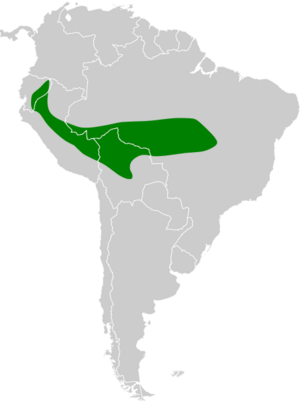Pale-rumped swift facts for kids
Quick facts for kids Pale-rumped swift |
|
|---|---|
| Conservation status | |
| Scientific classification | |
| Genus: |
Chaetura
|
| Species: |
egregia
|
 |
|
| Synonyms | |
|
Acanthylis egregia |
|
The pale-rumped swift (Chaetura egregia) is a small, fast-flying bird. It belongs to the swift family, Apodidae. You can find this bird in parts of Bolivia, Brazil, Colombia, Ecuador, and Peru.
Contents
About the Pale-rumped Swift
What's in a Name?
Scientists sometimes group animals based on how similar they are. The pale-rumped swift has been thought to be the same species as the grey-rumped swift at times. Other swifts like the band-rumped swift and the Lesser Antillean swift were once grouped with it too. But now, the pale-rumped swift is considered a unique species.
Appearance and Size
The pale-rumped swift is about 10.5 centimeters (4.1 inches) long. It weighs around 23 grams (0.8 ounces), which is about the same as a few quarters. This bird has a head that sticks out and a short, square tail. Its wings bulge in the middle and curve a bit at the ends. Both male and female pale-rumped swifts look alike.
Their upper parts are black with a shiny bronze look. They have a whitish rump and white feathers covering their upper tail. Their underparts are mostly dark. However, their throat is pale, and the feathers under their tail are blackish.
Where They Live
You can find the pale-rumped swift in eastern Ecuador, eastern Peru, western Brazil, and northwestern Bolivia. It has also been seen rarely in Colombia. These birds mostly live in tropical evergreen forests in lowlands. But they can also be found flying over more open areas and even in cities.
Life and Habits
Movement and Home
The pale-rumped swift is believed to live in the same areas all year round. This means they do not migrate to different places for seasons.
How They Eat
Like all swifts, the pale-rumped swift catches its food while flying. They eat insects in the air. These birds often fly and feed with other types of swifts. They usually stay in the lower part of the group when hunting for food. We don't know many details about what specific insects they eat.
Reproduction and Young
Not much is known about how the pale-rumped swift reproduces. Scientists have not yet described their nests or their eggs.
What They Sound Like
The pale-rumped swift makes a few different sounds. Their main call is a single "tsee." They also make more complex, chattering calls. These can sound like "tsee-titi" or "titi-tsee-trtr."
Conservation Status
The IUCN (International Union for Conservation of Nature) has listed the pale-rumped swift as a species of "Least Concern." This means they are not currently in danger of extinction. However, their total population size is not known. Scientists believe their numbers might be going down. No immediate threats to their survival have been found. While they are generally thought to be one of the rarer swifts, they are more common in some parts of Peru and even abundant in parts of Ecuador.


